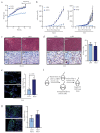Obesity-Activated Lung Stromal Cells Promote Myeloid Lineage Cell Accumulation and Breast Cancer Metastasis
- PMID: 33670906
- PMCID: PMC7957630
- DOI: 10.3390/cancers13051005
Obesity-Activated Lung Stromal Cells Promote Myeloid Lineage Cell Accumulation and Breast Cancer Metastasis
Abstract
Obesity is correlated with increased incidence of breast cancer metastasis; however, the mechanisms underlying how obesity promotes metastasis are unclear. In a diet-induced obese mouse model, obesity enhanced lung metastasis in both the presence and absence of primary mammary tumors and increased recruitment of myeloid lineage cells into the lungs. In the absence of tumors, obese mice demonstrated increased numbers of myeloid lineage cells and elevated collagen fibers within the lung stroma, reminiscent of premetastatic niches formed by primary tumors. Lung stromal cells isolated from obese tumor-naïve mice showed increased proliferation, contractility, and expression of extracellular matrix, inflammatory markers and transforming growth factor beta-1 (TGFβ1). Conditioned media from lung stromal cells from obese mice promoted myeloid lineage cell migration in vitro in response to colony-stimulating factor 2 (CSF2) expression and enhanced invasion of tumor cells. Together, these results suggest that prior to tumor formation, obesity alters the lung microenvironment, creating niches conducive to metastatic growth.
Keywords: breast cancer; collagen; lung fibroblasts; macrophages; metastasis; obesity.
Conflict of interest statement
The authors declare no conflict of interest.
Figures





Similar articles
-
Gut colonization with an obesity-associated enteropathogenic microbe modulates the premetastatic niches to promote breast cancer lung and liver metastasis.Front Immunol. 2023 Jul 12;14:1194931. doi: 10.3389/fimmu.2023.1194931. eCollection 2023. Front Immunol. 2023. PMID: 37503343 Free PMC article.
-
Stromal CCL2 Signaling Promotes Mammary Tumor Fibrosis through Recruitment of Myeloid-Lineage Cells.Cancers (Basel). 2020 Jul 28;12(8):2083. doi: 10.3390/cancers12082083. Cancers (Basel). 2020. PMID: 32731354 Free PMC article.
-
Stromally derived lysyl oxidase promotes metastasis of transforming growth factor-β-deficient mouse mammary carcinomas.Cancer Res. 2013 Sep 1;73(17):5336-46. doi: 10.1158/0008-5472.CAN-13-0012. Epub 2013 Jul 15. Cancer Res. 2013. PMID: 23856251 Free PMC article.
-
Lack of transforming growth factor-β signaling promotes collective cancer cell invasion through tumor-stromal crosstalk.Breast Cancer Res. 2012 Jul 2;14(4):R98. doi: 10.1186/bcr3217. Breast Cancer Res. 2012. PMID: 22748014 Free PMC article.
-
Molecular Basis of Lung Tropism of Metastasis.Cancer Genomics Proteomics. 2016 Mar-Apr;13(2):129-39. Cancer Genomics Proteomics. 2016. PMID: 26912803 Review.
Cited by
-
Obesity Does Not Increase Perioperative Outcomes in Older Patients Undergoing Thoracoscopic Anatomic Lung Cancer Surgery.Front Oncol. 2022 May 6;12:881467. doi: 10.3389/fonc.2022.881467. eCollection 2022. Front Oncol. 2022. PMID: 35600366 Free PMC article.
-
Breast cancer microenvironment and obesity: challenges for therapy.Cancer Metastasis Rev. 2022 Sep;41(3):627-647. doi: 10.1007/s10555-022-10031-9. Epub 2022 Apr 18. Cancer Metastasis Rev. 2022. PMID: 35435599 Free PMC article. Review.
-
Obesity and cancer-extracellular matrix, angiogenesis, and adrenergic signaling as unusual suspects linking the two diseases.Cancer Metastasis Rev. 2022 Sep;41(3):517-547. doi: 10.1007/s10555-022-10058-y. Epub 2022 Sep 8. Cancer Metastasis Rev. 2022. PMID: 36074318 Free PMC article. Review.
-
The obesity-breast cancer link: a multidisciplinary perspective.Cancer Metastasis Rev. 2022 Sep;41(3):607-625. doi: 10.1007/s10555-022-10043-5. Epub 2022 Jun 25. Cancer Metastasis Rev. 2022. PMID: 35752704 Free PMC article. Review.
-
Alterations in the mammary gland and tumor microenvironment of formerly obese mice.BMC Cancer. 2023 Dec 1;23(1):1183. doi: 10.1186/s12885-023-11688-3. BMC Cancer. 2023. PMID: 38041006 Free PMC article.
References
-
- World Health Organization Obesity and Overweight Fact Sheet. [(accessed on 15 August 2020)];2020 Available online: https://www.who.int/news-room/fact-sheets/detail/obesity-and-overweight.
-
- Lahmann P.H., Hoffmann K., Allen N., van Gils C.H., Khaw K.T., Tehard B., Berrino F., Tjønneland A., Bigaard J., Olsen A., et al. Body size and breast cancer risk: Findings from the European Prospective Investigation into Cancer and Nutrition (EPIC) Int. J. Cancer. 2004;111:762–771. doi: 10.1002/ijc.20315. - DOI - PubMed
Grants and funding
LinkOut - more resources
Full Text Sources
Other Literature Sources

